Irrigation and Planting Density Effects on Apple–Peanut Intercropping System
Abstract
1. Introduction
2. Materials and Methods
2.1. Study Area Overview
2.2. Experimental Materials
2.3. Experimental Design
2.4. Measurement Items and Methods
2.4.1. Soil Moisture
2.4.2. Water Use Calculation
2.4.3. Measurement of Comprehensive Physiological Indices in Alley Cropping System Crops
- (1)
- Soil Plant Analysis Development
- (2)
- Leaf Area Index (LAI)
- (3)
- Apple Shoot Growth and Peanut Plant Height
- (4)
- Apple and Peanut Root Systems
- (5)
- Yield
2.5. Data Processing and Statistical Analysis
3. Results and Analysis
3.1. Effects of Intercropping Density and Water Regulation on Spatial Distribution of Soil Moisture Content
3.1.1. Horizontal Profile
3.1.2. Vertical Profile
3.2. Effects of Intercropping Density and Water Regulation on Fine Root Distribution in Apple and Peanut
3.3. Effects of Intercropping Density and Water Regulation on Physiological Growth in the Alley Cropping System
3.3.1. Soil–Plant Analysis Development Value
3.3.2. Leaf Area Index (LAI)
3.3.3. New Shoot Growth and Plant Height
3.4. Effects of Water Regulation and Planting Density on Apple–Peanut Yield and Water Use Efficiency
3.5. Comprehensive Benefits and Regression Analysis of the Alley Cropping System
4. Discussion
4.1. Effects of Water Regulation and Planting Density on Soil Moisture and Root Distribution
4.2. Effects of Water Regulation and Planting Density on Apple and Peanut Physiological Growth
4.3. Effects of Water Regulation and Planting Density on Water Use and Comprehensive Benefits in Apple and Peanut
5. Conclusions
Author Contributions
Funding
Data Availability Statement
Acknowledgments
Conflicts of Interest
References
- Xiao, G.J.; Zhang, F.J.; Qiu, Z.J.; Yao, Y.B.; Wang, R.Y.; Huang, J.Y. Response to climate change for potato water use efficiency in semi-arid areas of China. Agric. Water Manag. 2013, 127, 119–123. [Google Scholar] [CrossRef]
- Zhang, Y.; Zhao, X.L. Dynamic Evaluation and Analysis on Ecosystem Service Value in the Loess Plateau. Res. Soil Water Conserv. 2018, 25, 170–176. [Google Scholar]
- Wang, C.; Liu, X.F. Spatial pattern, tradeoffs and synergies of ecosystem services in loess hilly region: A casestudy in Yuzhong County. Chin. J. Ecol. 2019, 38, 521–531. [Google Scholar]
- Cong, W.F.; Hoffland, E.; Li, L.; Six, J.; Sun, J.H.; Bao, X.G.; Zhang, F.S.; van der Werf, W. Intercropping enhances soil carbon and nitrogen. Glob. Change Biol. 2015, 21, 1715–1726. [Google Scholar] [CrossRef]
- Wang, J.; Guo, J.L. The Correlation Between Soil Temperature and Water Content During the Natural VegetationRestoration on the Loess Plateau. J. Soil Water Conserv. 2022, 36, 130–137. [Google Scholar]
- Zheng, C.H.; Wang, R.S.; Zhou, X.; Li, C.N.; Dou, X.Y. Effects of mulch and irrigation regimes on water distribution and root competition in an apple-soybean intercropping system in Loess Plateau, China. Agric. Water Manag. 2021, 246, 106656. [Google Scholar] [CrossRef]
- Dou, X.; Wang, R.; Zhou, X.; Gao, F.; Yu, Y.; Li, C.; Zheng, C. Soil water, nutrient distribution and use efficiencies under different water and fertilizer coupling in an apple-maize alley cropping system in the Loess Plateau, China. Soil Tillage Res. 2022, 218, 105308. [Google Scholar] [CrossRef]
- Ren, Y.; Liu, J.; Wang, Z.; Zhang, S. Planting density and sowing proportions of maize-soybean intercrops affected competitive interactions and water-use efficiencies on the Loess Plateau, China. Eur. J. Agron. 2016, 72, 70–79. [Google Scholar] [CrossRef]
- Zhou, X.; Wang, R.S.; Gao, F.; Xiao, H.J.; Xu, H.S.; Wang, D.M. Apple and maize physiological characteristics and water-use efficiency in an alley cropping system under water and fertilizer coupling in Loess Plateau, China. Agric. Water Manag. 2019, 221, 1–12. [Google Scholar] [CrossRef]
- Zheng, H.; Hou, H.; Wu, J.; Tian, D.; Miao, P. Irrigation Schedule Optimization for Wheat and Sunflower Intercropping under Water Supply Restrictions in Inner Mongolia, China. Atmosphere 2024, 15, 566. [Google Scholar] [CrossRef]
- Yang, C.H.; Chai, Q.; Huang, G.B. Root distribution and yield responses of wheat/maize intercropping to alternate irrigation in the arid areas of northwest China. Plant Soil Environ. 2010, 56, 253–262. [Google Scholar] [CrossRef]
- Dai, H.; Wang, R.; Chen, L.; Wang, L.; Xiong, C.; Wang, X.; Zhang, M. Effects of Different Micro-Irrigation Methods on Water Use and the Economic Benefits of an Apple-Soybean Intercropping System. Agronomy 2023, 13, 1143. [Google Scholar] [CrossRef]
- Wolz, K.J.; DeLucia, E.H. Alley cropping: Global patterns of species composition and function. Agric. Ecosyst. Environ. 2018, 252, 61–68. [Google Scholar] [CrossRef]
- Yang, H.; Chai, Q.; Yin, W.; Hu, F.; Qin, A.; Fan, Z.; Yu, A.; Zhao, C.; Fan, H. Yield photosynthesis and leaf anatomy of maize in inter- and mono-cropping systems at varying plant densities. Crop J. 2022, 10, 893–903. [Google Scholar] [CrossRef]
- Wang, Q.; Sun, Z.; Bai, W.; Zhang, D.; Zhang, Y.; Wang, R.; Van der Werf, W.; Evers, J.B.; Stomph, T.-J.; Guo, J.; et al. Light interception and use efficiency differ with maize plant density in maize-peanut intercropping. Front. Agric. Sci. Eng. 2021, 8, 432–446. [Google Scholar] [CrossRef]
- Fan, Z.; Zhao, Y.; Chai, Q.; Zhao, C.; Yu, A.; Coulter, J.A.; Gan, Y.; Cao, W. Synchrony of nitrogen supply and crop demand are driven via high maize density in maize/pea strip intercropping. Sci. Rep. 2019, 9, 10954. [Google Scholar] [CrossRef]
- Zegada-Lizarazu, W.; Kanyomeka, L.; Izumi, Y.; Iijima, M. Pearl millet developed deep roots and changed water sources by competition with intercropped cowpea in the semiarid environment of northern Namibia. Plant Prod. Sci. 2006, 9, 355–363. [Google Scholar] [CrossRef]
- Yang, B.; Meng, X.; Singh, A.K.; Wang, P.; Song, L.; Zakari, S.; Liu, W. Intercrops improve surface water availability in rubber-based agroforestry systems. Agric. Ecosyst. Environ. 2020, 298, 106937. [Google Scholar] [CrossRef]
- Shen, L.; Wang, X.; Liu, T.; Wei, W.; Zhang, S.; Zhu, Y.; Tuerti, T.; Li, L.; Zhang, W. Apple-Soybean Mixed Stand Increased Fine Root Distribution and Soil Water Content with Reduced Soil Nitrate Nitrogen. Agronomy 2023, 13, 548. [Google Scholar] [CrossRef]
- Duan, Z.P.; Gan, Y.W.; Wang, B.J.; Hao, X.D.; Xu, W.L.; Zhang, W.; Li, L.H. Interspecific interaction alters root morphology in young walnut/wheat agroforestry systems in northwest China. Agrofor. Syst. 2019, 93, 419–434. [Google Scholar] [CrossRef]
- Li, L.; Sun, J.; Zhang, F.; Li, X.; Rengel, Z.; Yang, S. Wheat/maize or wheat/soybean strip intercropping: II. Recovery or compensation of maize and soybean after wheat harvesting. Field Crops Res. 2001, 71, 173–181. [Google Scholar] [CrossRef]
- Zhang, L.; van der Werf, W.; Bastiaans, L.; Zhang, S.; Li, B.; Spiertz, J.H.J. Light interception and utilization in relay intercrops of wheat and cotton. Field Crops Res. 2008, 107, 29–42. [Google Scholar] [CrossRef]
- Zhao, J.; Han, T.; Wang, C.; Jia, H.; Worqlul, A.W.; Norelli, N.; Zeng, Z.H.; Chu, Q.Q. Optimizing irrigation strategies to synchronously improve the yield and water productivity of winter wheat under interannual precipitation variability in the North China Plain. Agric. Water Manag. 2020, 240, 106298. [Google Scholar] [CrossRef]
- Dou, X.Y.; Wang, R.S.; Li, C.N.; Zheng, C.H.; Zhou, X. Spatial distribution of soil water, plant roots, and water use pattern under different drip fertigation regimes in an apple-soybean intercropping system on the Loess Plateau, China. Agric. Water Manag. 2022, 269, 107718. [Google Scholar] [CrossRef]
- Li, C.N.; Wang, R.S. Effects of Water and Fertilizer Regulation on Photosynthetic CharacteristicsYield and Water Use of Apple soybean Intercropping System Under Drip lrrigation. J. Soil Water Conserv. 2020, 34, 299–310. [Google Scholar]
- Xu, F.Q. Analysis of effective precipitation. Meteorol. Hydrol. Mar. Instrum. 2009, 26, 96–100. [Google Scholar]
- Liao, W.C.; Bi, H.X. Distribution of soil moisture in Malus pumila and Glycine maxintercropping system and its impact on the soybean growth. Sci. Soil Water Conserv. 2014, 12, 24–28. [Google Scholar]
- Kang, S.Z.; Hao, X.M.; Du, T.S.; Tong, L.; Su, X.L.; Lu, H.N.; Li, X.L.; Huo, Z.L.; Li, S.E.; Ding, R.S. Improving agricultural water productivity to ensure food security in China under changing environment: From research to practice. Agric. Water Manag. 2017, 179, 5–17. [Google Scholar] [CrossRef]
- Pelech, E.A.; Evers, J.B.; Pederson, T.L.; Drag, D.W.; Fu, P.; Bernacchi, C.J. Leaf, plant, to canopy: A mechanistic study on aboveground plasticity and plant density within a maize-soybean intercrop system for the Midwest, USA. Plant Cell Environ. 2023, 46, 405–421. [Google Scholar] [CrossRef]
- Singh, K.; Singh, K.; Brar, A.S.; Sahoo, P.; Gupta, N.; Mishra, S.K. Water Productivity of Sugarcane plus Summer Moong Intercropping System Under Subsurface Drip Irrigation and Straw Mulching. Sugar Tech 2024, 26, 876–893. [Google Scholar] [CrossRef]
- Mehrabi, F.; Sepaskhah, A.R. Leaf Nitrogen, Based on SPAD Chlorophyll Reading Can Determine Agronomic Parameters of Winter Wheat. Int. J. Plant Prod. 2022, 16, 77–91. [Google Scholar] [CrossRef]
- Zhang, J. Effeets of different dense planting methods on leaf funetion and yield ofsummer-sowing peanut. Chin. J. Oil Crop Sci. 2021, 43, 656–663. [Google Scholar]
- Huang, X.S. Effects of Density and Potassium Fertilizer on PhotosyntheticPhysiological Characteristics and Yield of Peanutunder Intercropping with Apricot Trees. Shandong Agric. Sci. 2025, 57, 72–80. [Google Scholar]
- Adekaldu, E.; Amponsah, W.; Tuffour, H.O.; Adu, M.O.; Agyare, W.A. Response of chilli pepper to different irrigation schedules and mulching technologies in semi-arid environments. J. Agric. Food Res. 2021, 6, 100222. [Google Scholar] [CrossRef]
- Wang, Z.; Wang, C.; Tan, X.; Gao, G.; El-Badri, A.M.; Batool, M.; Li, Z.; Ai, X.; Kuai, J.; Wang, J.; et al. Diversified spatial configuration of rapeseed-vetch intercropping benefits soil quality, radiation utilization, and forage production in the Yangtze River Basin. Field Crops Res. 2024, 318, 109587. [Google Scholar] [CrossRef]
- Raza, M.A.; Din, A.M.U.; Shah, G.A.; Wang, Z.; Feng, L.Y.; Gul, H.; Yasin, H.S.; Rahman, M.S.u.; Juan, C.; Liang, X.; et al. Legume choice and planting configuration influence intercrop nutrient and yield gains through complementarity and selection effects in legume-based wheat intercropping systems. Agric. Syst. 2024, 220, 104081. [Google Scholar] [CrossRef]
- Li, S.; van Der Werf, W.; Zhu, J.; Guo, Y.; Li, B.; Ma, Y.; Evers, J.B. Estimating the contribution of plant traits to light partitioning in simultaneous maize/soybean intercropping. J. Exp. Bot. 2021, 72, 3630–3646. [Google Scholar] [CrossRef] [PubMed]
- Yang, C.H.; Huang, G.B.; Chai, Q.; Luo, Z.X. Water use and yield of wheat/maize intercropping under alternate irrigation in the oasis field of northwest China. Field Crops Res. 2011, 124, 426–432. [Google Scholar] [CrossRef]
- Chen, L.; Wang, R.S.; Xiao, W.; Wang, L.S. Optimizing irrigation and mulching strategies to improve root-water relations, water use efficiency, and yield in apple-soybean alley cropping systems on the Loess Plateau, China. Eur. J. Agron. 2025, 168, 127586. [Google Scholar] [CrossRef]
- Shen, X.F.; Zhao, Z.H.; Chen, Y. Effects of Intercropping with Peanut and Silicon Application on Sugarcane Growth, Yield and Quality. Sugar Tech 2019, 21, 437–443. [Google Scholar] [CrossRef]
- Hauggaard-Nielsen, H.; Andersen, M.K.; Jornsgaard, B.; Jensen, E.S. Density and relative frequency effects on competitive interactions and resource use in pea-barley intercrops. Field Crops Res. 2006, 95, 256–267. [Google Scholar] [CrossRef]
- Wei, W.W.; Liu, T.T.; Shen, L.; Wang, X.Y.; Zhang, S.; Zhang, W. Effect of Maize (Zeal mays) and Soybean (Glycine max) Intercropping on Yield and Root Development in Xinjiang, China. Agriculture 2022, 12, 996. [Google Scholar] [CrossRef]
- Zhang, W.P.; Li, Z.X.; Gao, S.N.; Yang, H.; Xu, H.S.; Yang, X.; Fan, H.X.; Su, Y.; Surigaoge; Weiner, J.; et al. Resistance vs. surrender: Different responses of functional traits of soybean and peanut to intercropping with maize. Field Crops Res. 2023, 291, 108779. [Google Scholar] [CrossRef]
- Zheng, Z.G.; Wang, X.L. Effects of Sowing Date and Planting Density on Agronomic Traits and Yield of a New High-Oleic Peanut Cultivar Yuhua 37. Bull. Agric. Sci. Technol. 2021, 5, 140–142. [Google Scholar]
- Ma, X.L.; Zhu, Q.L.; Geng, C.X.; Lu, Z.G.; Long, G.Q.; Tang, L. Contribution of nutrient uptake and utilization on yield advantage in maize and potato intercropping under different nitrogen application rates. Ying Yong Sheng Tai Xue Bao = J. Appl. Ecol. 2017, 28, 1265–1273. [Google Scholar]
- Wang, L.S.; Wang, R.S.; Luo, C.W.; Dai, H.S.; Xiong, C.; Wang, X.; Zhang, M.; Xiao, W. Effects of Different Soil Water and Heat Regulation Patterns on the Physiological Growth and Water Use in an Apple-Soybean Intercropping System. Agronomy 2023, 13, 511. [Google Scholar] [CrossRef]
- Wang, Q.; Bai, W.; Sun, Z.X.; Zhang, D.S.; Zhang, Y.; Wang, R.N.; Evers, J.B.; Stomph, T.J.; van der Werf, W.; Feng, C.; et al. Does reduced intraspecific competition of the dominant species in intercrops allow for a higher population density? Food Energy Secur. 2021, 10, 285–298. [Google Scholar] [CrossRef]
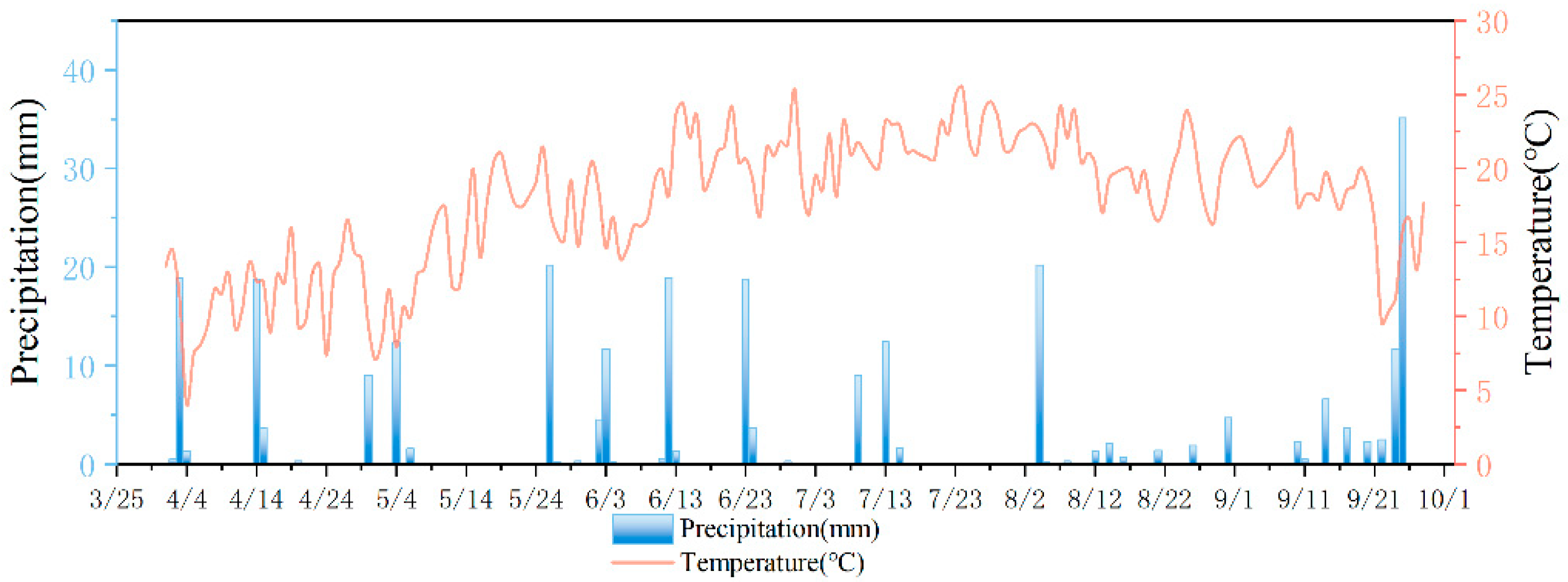
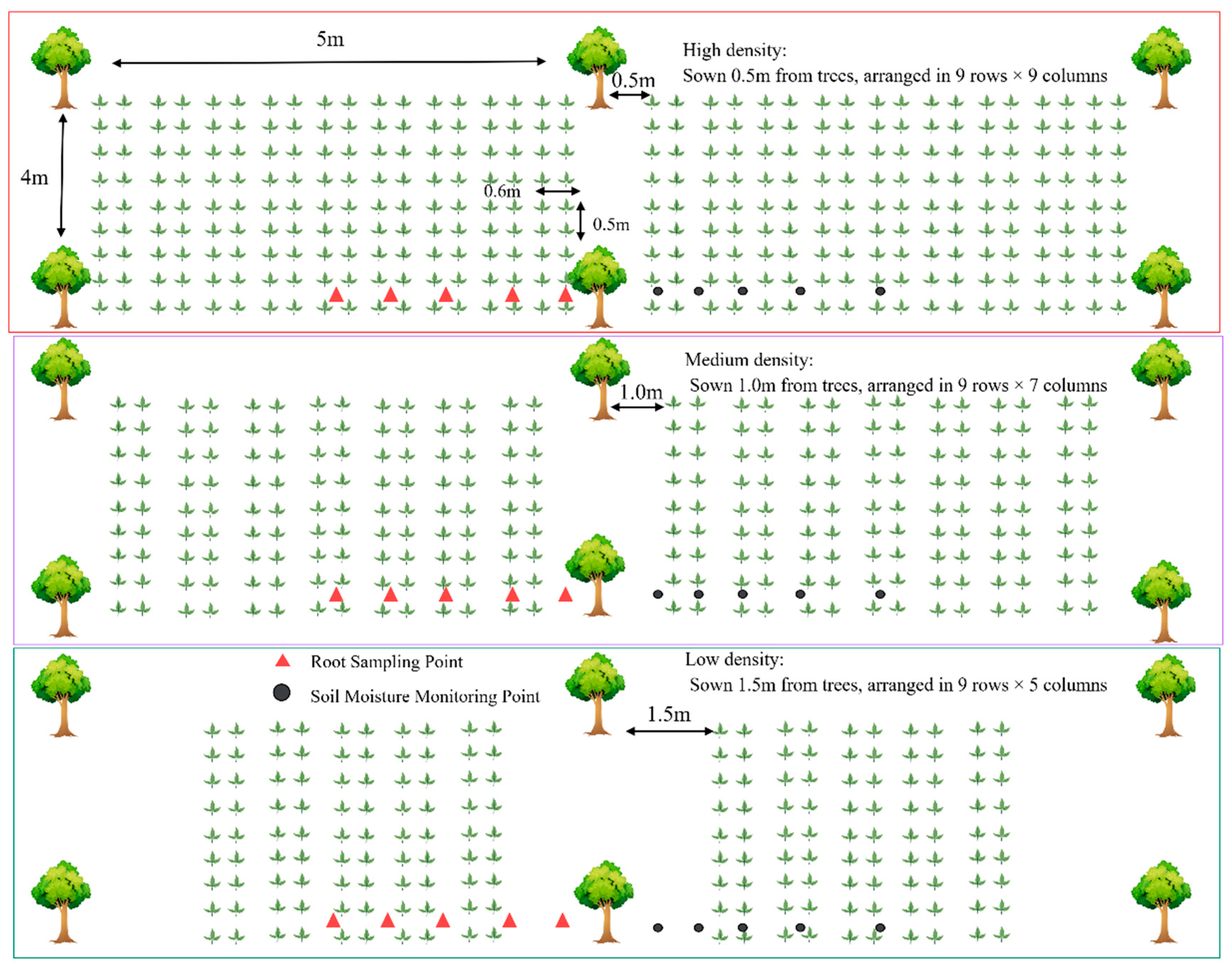
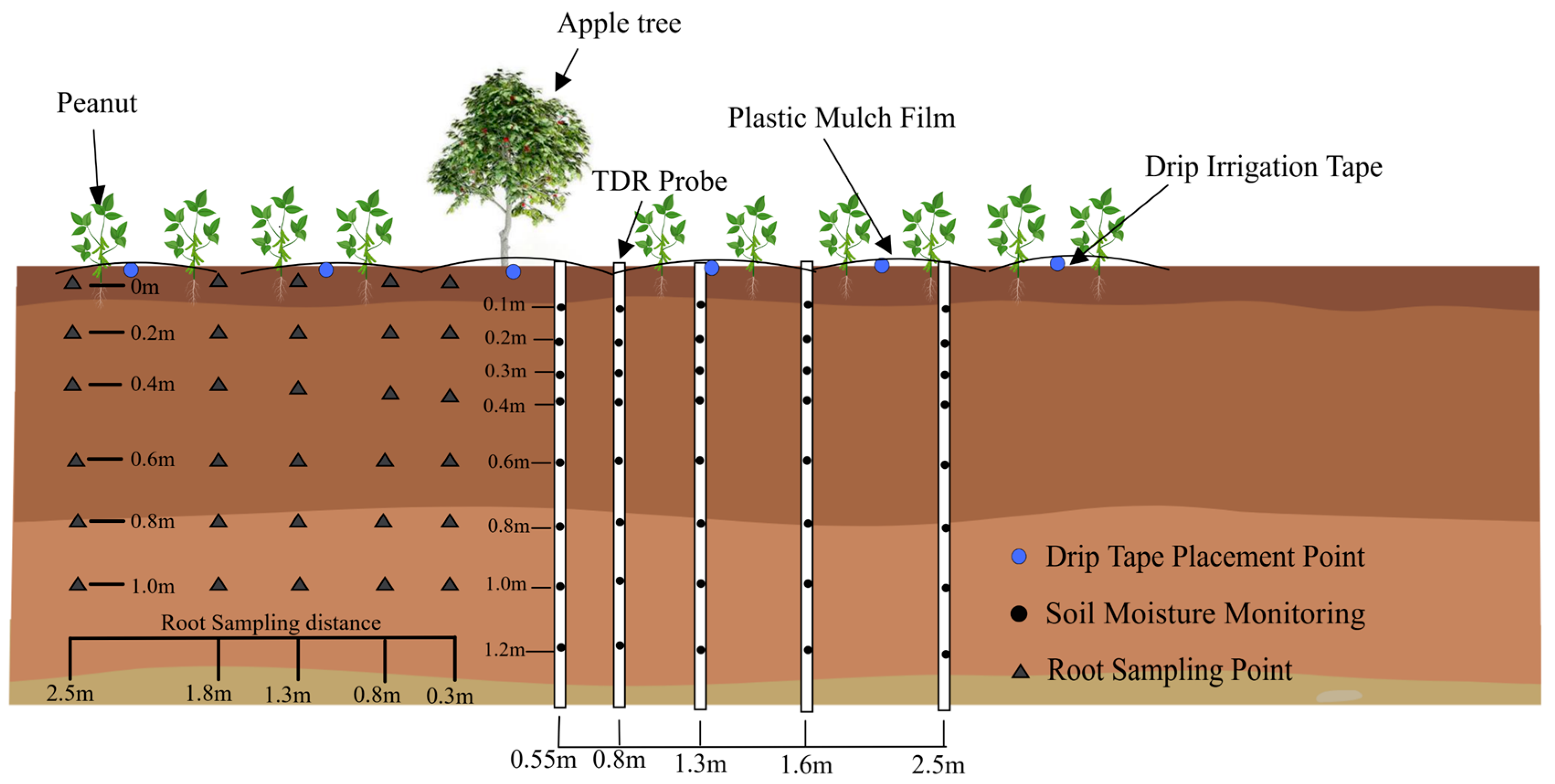
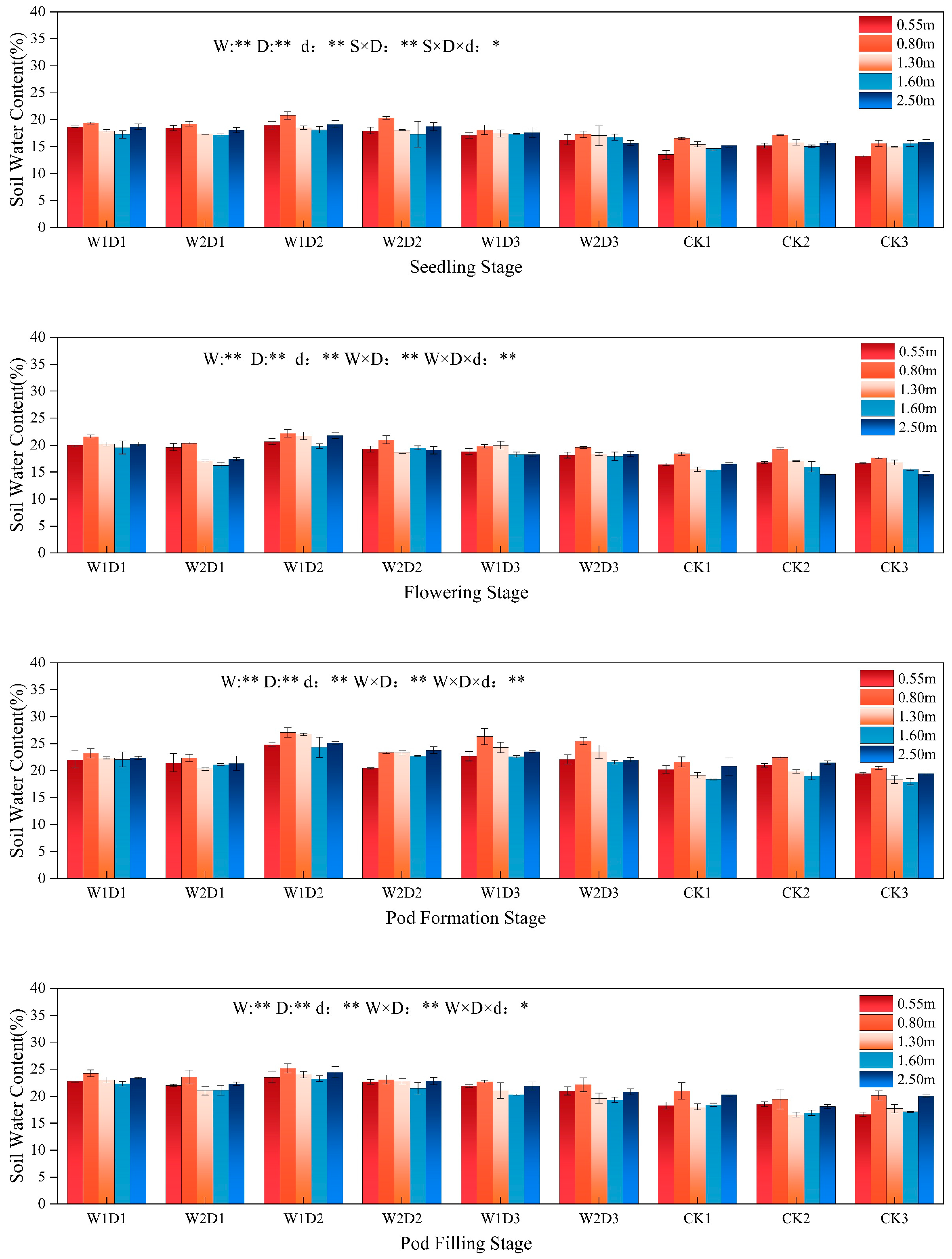
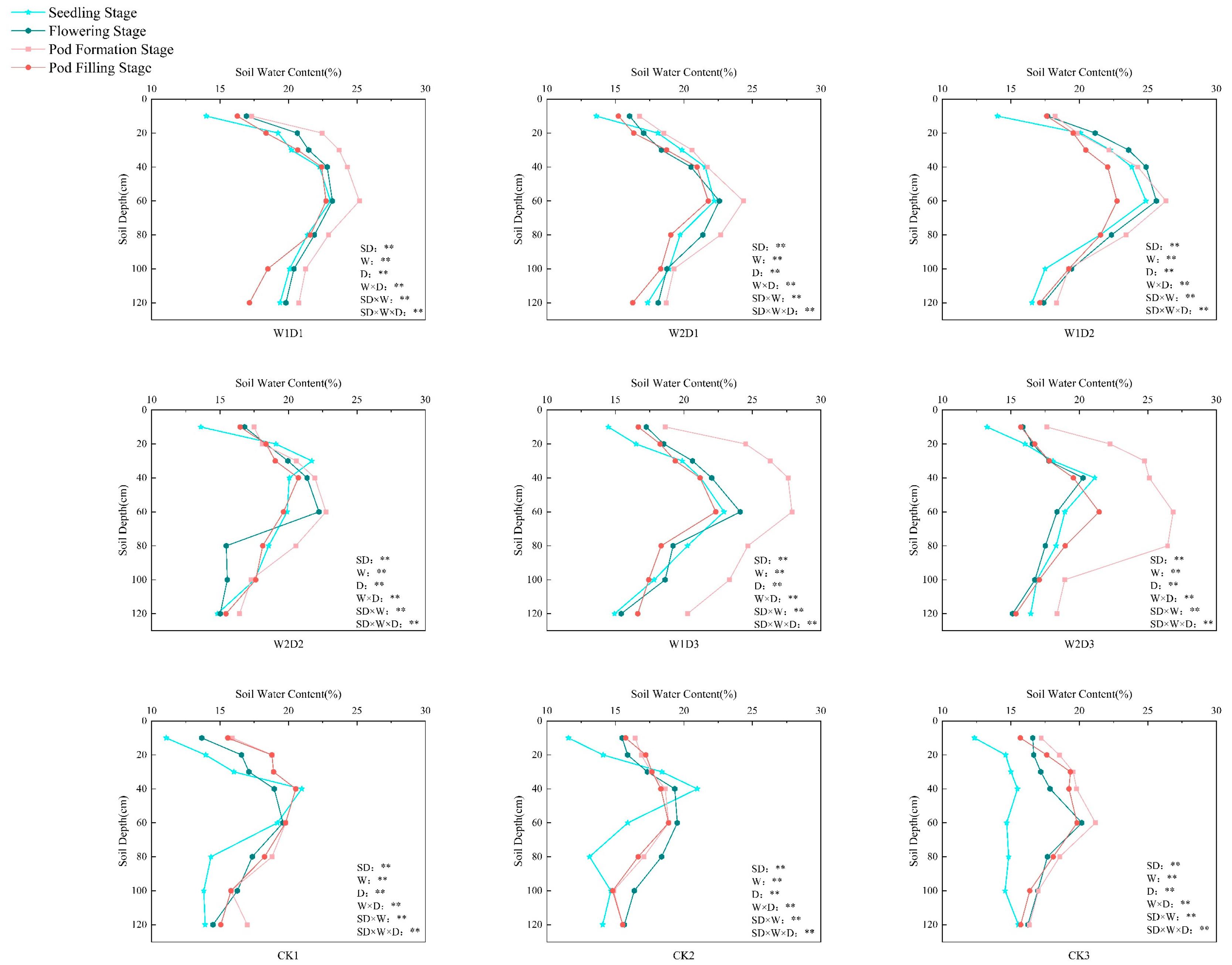
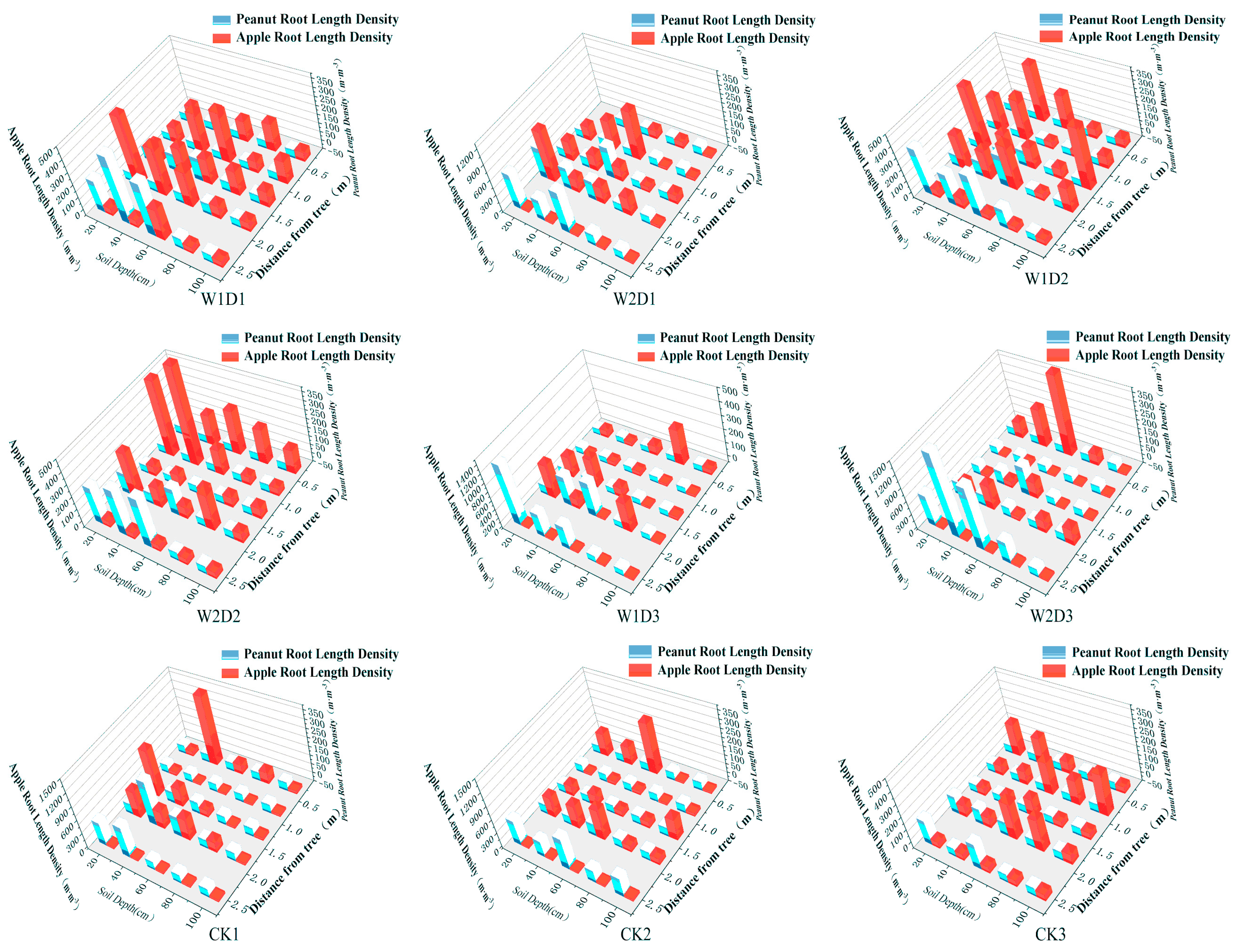
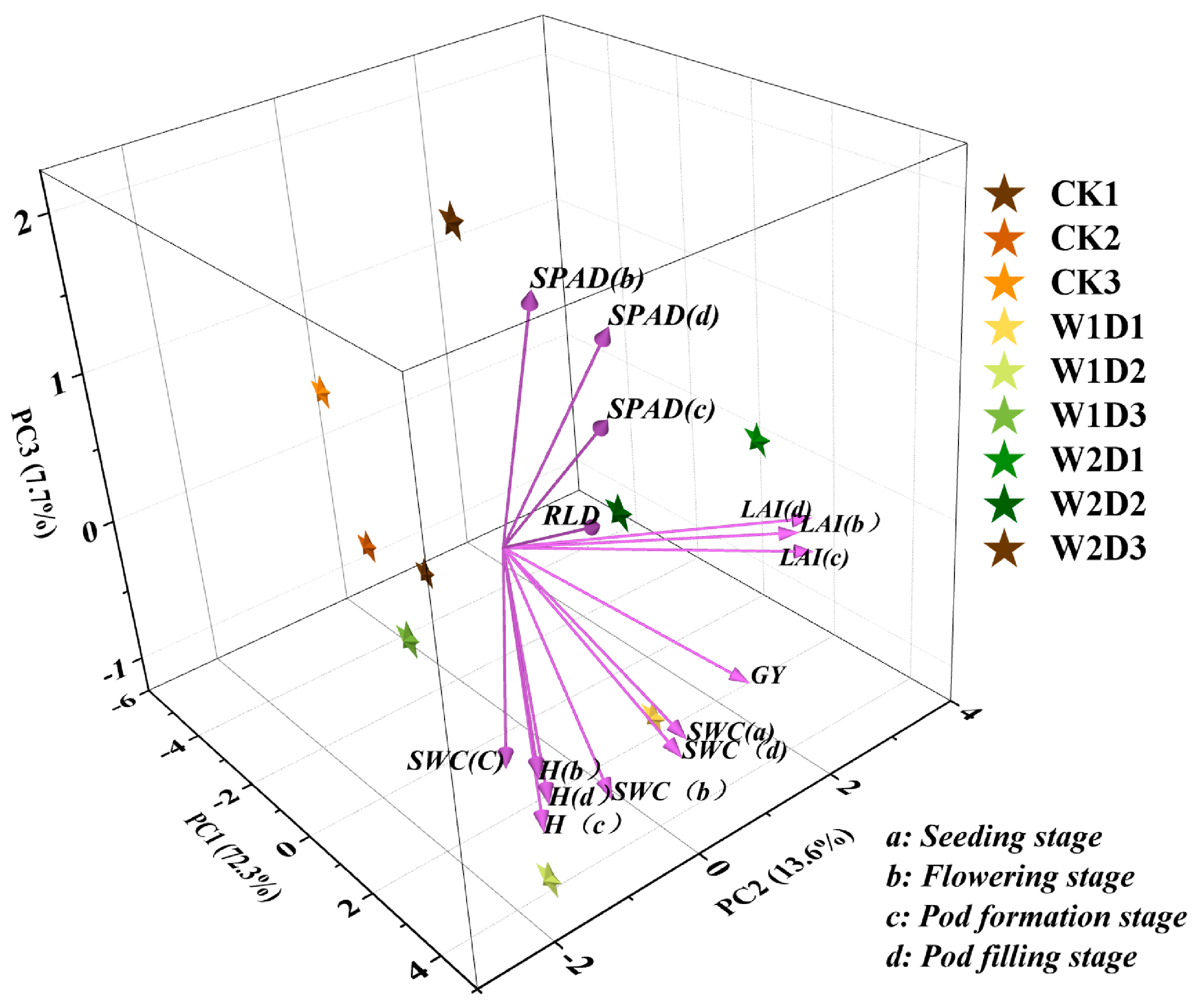
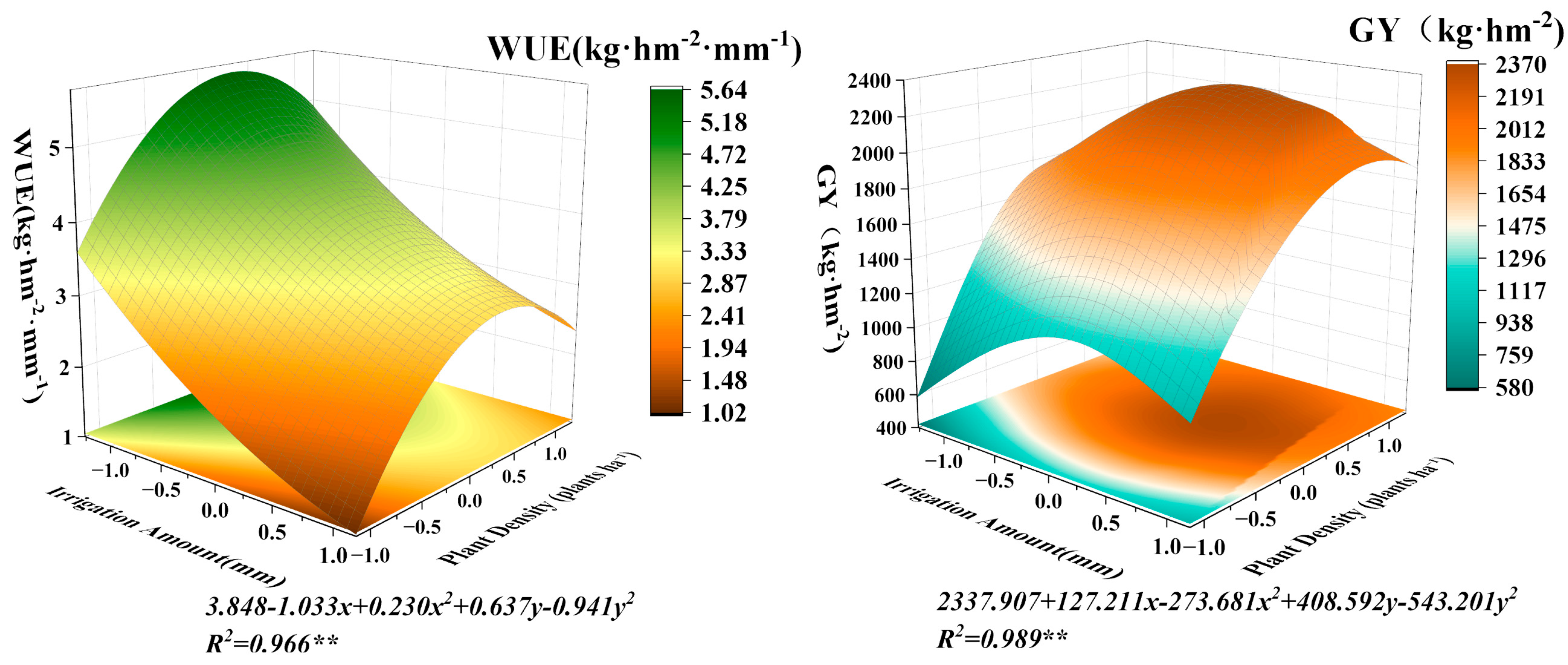
| Treatment | Irrigation Amount (m3·ha−1) | Mulching Method | Planting Density (Plants/ha) | ||
|---|---|---|---|---|---|
| Flowering Stage | Pod Formation Stage | Pod-Filling Stage | |||
| W1D1 | 162.1 | 180.8 | 186.0 | Drip irrigation under plastic mulch-85%FC | 27,500 |
| W2D1 | 121.4 | 126.7 | 124.5 | Drip irrigation under plastic mulch-65%FC | 27,500 |
| W1D2 | 173.0 | 195.5 | 214.1 | Drip irrigation under plastic mulch-85%FC | 18,333 |
| W2D2 | 125.8 | 135.6 | 147.4 | Drip irrigation under plastic mulch-65%FC | 18,333 |
| W1D3 | 196.6 | 213.2 | 225.8 | Drip irrigation under plastic mulch-85%FC | 10,833 |
| W2D3 | 118.5 | 142.2 | 163.1 | Drip irrigation under plastic mulch-65%FC | 10,833 |
| CK1 | / | / | / | Mulching without irrigation | 27,500 |
| CK2 | / | / | / | Mulching without irrigation | 18,333 |
| CK3 | / | / | / | Mulching without irrigation | 10,833 |
| SPAD | ||||||
|---|---|---|---|---|---|---|
| Treatment | Apple | Peanut | ||||
| Bud Break Stage | Fruit-Setting Stage | Fruit-Expansion Stage | Flowering Stage | Pod Formation Stage | Pod-Filling Stage | |
| W1D1 | 41.04 ± 0.62 d | 46.49 ± 0.61 c | 43.08 ± 0.67 d | 52.05 ± 0.55 f | 55.32 ± 1.05 d | 53.77 ± 0.88 de |
| W2D1 | 43.10 ± 0.72 c | 47.35 ± 0.54 c | 46.03 ± 0.30 bc | 53.43 ± 0.78 de | 57.16 ± 0.29 c | 56.04 ± 1.22 bc |
| W1D2 | 44.17 ± 0.67 bc | 48.72 ± 0.60 b | 45.07 ± 0.38 c | 55.40 ± 1.01 bc | 59.18 ± 0.35 b | 56.89 ± 0.68 b |
| W2D2 | 45.06 ± 0.36 b | 52.13 ± 0.81 a | 49.01 ± 0.89 a | 58.39 ± 0.69 a | 62.75 ± 0.71 a | 60.43 ± 0.53 a |
| W1D3 | 43.83 ± 1.03 bc | 47.19 ± 0.63 c | 45.55 ± 0.37 c | 54.63 ± 0.52 cd | 57.53 ± 0.95 c | 56.61 ± 1.13 bc |
| W3D3 | 46.96 ± 1.23 a | 48.85 ± 0.59 b | 46.61 ± 0.50 b | 56.14 ± 0.93 b | 58.87 ± 0.74 b | 57.32 ± 0.80 b |
| CK1 | 36.58 ± 1.23 f | 40.67 ± 0.51 f | 38.85 ± 0.61 g | 49.87 ± 0.43 g | 53.63 ± 0.59 e | 52.24 ± 0.97 e |
| CK2 | 38.74 ± 0.40 e | 42.23 ± 0.89 e | 40.60 ± 0.55 f | 52.53 ± 0.69 ef | 55.23 ± 0.48 d | 53.25 ± 0.80 e |
| CK3 | 40.54 ± 0.35 d | 43.97 ± 0.55 d | 41.93 ± 0.51 e | 51.86 ± 0.89 f | 54.71 ± 0.63 de | 55.12 ± 1.10 cd |
| Significance test (F-value) | ||||||
| W | 85.527 ** | 123.539 ** | 50.483 ** | 148.939 ** | 293.839 ** | 336.163 ** |
| D | 56.395 ** | 65.234 ** | 23.974 ** | 45.150 ** | 45.145 ** | 44.631 ** |
| W × D | 2.111 ns | 7.714 ** | 5.810 ** | 1.865 ns | 13.334 ** | 9.620 ** |
| Leaf Area Index | ||||||
|---|---|---|---|---|---|---|
| Treatment | Apple | Peanut | ||||
| Bud Break Stage | Fruit-Setting Stage | Fruit-Expansion Stage | Flowering Stage | Pod Formation Stage | Pod-Filling Stage | |
| W1D1 | 2.63 ± 0.17 b | 3.08 ± 0.22 b | 2.77 ± 0.11 b | 1.76 ± 0.09 b | 2.83 ± 0.11 ab | 3.18 ± 0.08 b |
| W2D1 | 3.45 ± 0.13 a | 4.30 ± 0.17 a | 4.10 ± 0.02 a | 2.16 ± 0.12 a | 3.11 ± 0.22 a | 4.28 ± 0.20 a |
| W1D2 | 2.26 ± 0.17 cd | 2.86 ± 0.17 cd | 2.56 ± 0.10 cd | 1.52 ± 0.03 bc | 2.15 ± 0.37 c | 2.73 ± 0.16 c |
| W2D2 | 2.40 ± 0.06 c | 2.97 ± 0.06 bc | 2.67 ± 0.03 bc | 1.64 ± 0.16 bc | 2.58 ± 0.27 b | 2.99 ± 0.10 b |
| W1D3 | 1.81 ± 0.12 e | 2.63 ± 0.04 e | 2.32 ± 0.10 e | 1.36 ± 0.08 cd | 1.74 ± 0.04 de | 2.33 ± 0.12 d |
| W2D3 | 2.19 ± 0.13 cd | 2.74 ± 0.07 de | 2.49 ± 0.04 de | 1.46 ± 0.03 c | 1.95 ± 0.16 cd | 2.47 ± 0.28 d |
| CK1 | 2.11 ± 0.03 d | 2.55 ± 0.11 e | 2.26 ± 0.06 e | 1.16 ± 0.06 de | 1.63 ± 0.13 def | 2.03 ± 0.12 e |
| CK2 | 1.78 ± 0.17 e | 2.30 ± 0.05 f | 2.15 ± 0.04 f | 0.92 ± 0.37 ef | 1.45 ± 0.11 ef | 1.85 ± 0.08 ef |
| CK3 | 1.74 ± 0.08 e | 2.16 ± 0.04 f | 1.85 ± 0.07 f | 0.78 ± 0.16 f | 1.33 ± 0.19 f | 1.60 ± 0.12 f |
| Significance test (F-value) | ||||||
| W | 88.835 ** | 153.846 ** | 452.887 ** | 62.574 ** | 68.823 ** | 206.633 ** |
| D | 97.873 ** | 108.268 ** | 323.210 ** | 22.826 ** | 40.486 ** | 106.676 ** |
| W × D | 12.185 ** | 29.094 ** | 101.900 ** | 1.160 ns | 4.411 * | 19.045 ** |
| New Shoot Growth and Plant Height | ||||||
|---|---|---|---|---|---|---|
| Treatment | Apple | Peanut | ||||
| Bud Break Stage | Fruit-Setting Stage | Fruit-Expansion Stage | Flowering Stage | Pod Formation Stage | Pod-Filling Stage | |
| W1D1 | 34.41 ± 0.42 e | 41.11 ± 0.73 e | 47.62 ± 0.53 e | 21.63 ± 0.36 d | 32.33 ± 0.30 d | 36.66 ± 0.28 d |
| W2D1 | 32.23 ± 0.88 f | 39.33 ± 0.86 f | 44.59 ± 0.65 f | 19.46 ± 0.40 e | 30.60 ± 0.57 e | 34.69 ± 0.58 e |
| W1D2 | 39.67 ± 0.53 b | 50.41 ± 0.71 b | 55.44 ± 0.57 b | 26.59 ± 0.72 a | 37.87 ± 0.79 a | 42.27 ± 0.14 a |
| W2D2 | 36.30 ± 0.63 d | 44.85 ± 0.81 d | 49.54 ± 0.68 d | 23.78 ± 0.68 c | 34.71 ± 0.67 c | 39.80 ± 0.06 c |
| W1D3 | 41.58 ± 0.45 a | 53.71 ± 0.61 a | 62.52 ± 0.58 a | 24.84 ± 0.54 b | 35.87 ± 0.67 b | 40.72 ± 0.44 b |
| W2D3 | 38.42 ± 0.46 c | 47.78 ± 0.59 c | 51.77 ± 0.73 c | 18.29 ± 0.28 f | 29.08 ± 0.30 f | 33.62 ± 0.61 f |
| CK1 | 26.89 ± 0.21 h | 34.45 ± 0.39 h | 39.85 ± 0.54 h | 14.18 ± 0.25 i | 26.76 ± 0.68 h | 30.29 ± 0.42 h |
| CK2 | 27.27 ± 0.32 h | 35.22 ± 0.13 h | 42.71 ± 0.52 g | 15.52 ± 0.35 h | 28.02 ± 0.51 g | 31.78 ± 0.88 g |
| CK3 | 30.08 ± 0.26 g | 38.05 ± 0.53 g | 44.18 ± 0.25 f | 17.02 ± 0.23 g | 26.40 ± 0.39 h | 29.41 ± 0.54 i |
| Significance test (F-value) | ||||||
| W | 1045.418 ** | 907.453 ** | 1128.687 ** | 825.427 ** | 484.793 ** | 800.008 ** |
| D | 275.095 ** | 389.705 ** | 527.691 ** | 135.315 ** | 108.179 ** | 170.213 ** |
| W × D | 21.810 ** | 48.483 ** | 67.949 ** | 52.468 ** | 25.998 ** | 39.145 ** |
| Treatment | Apple GY/(kg·hm−2) | Peanut GY/(kg·hm−2) | ET/(mm) | WUE/(kg·hm−2·mm−1) |
|---|---|---|---|---|
| W1D1 | 152.89 ± 2.74 d | 1966.09 ± 27.52 d | 817.50 ± 32.91 b | 2.59 ± 0.03 c |
| W2D1 | 167.44 ± 3.19 bc | 2074.60 ± 50.02 c | 670.63 ± 13.63 d | 3.34 ± 0.07 b |
| W1D2 | 202.38 ± 4.33 a | 2183.34 ± 21.39 b | 875.44 ± 8.83 a | 2.73 ± 0.03 c |
| W2D2 | 212.23 ± 5.38 a | 2380.39 ± 19.08 a | 696.58 ± 33.47 c | 3.72 ± 0.03 a |
| W1D3 | 163.99 ± 10.63 cd | 943.41 ± 13.99 f | 886.59 ± 15.22 a | 1.25 ± 0.03 e |
| W2D3 | 176.83 ± 6.57 b | 1094.57 ± 13.17 e | 674.40 ± 54.03 d | 1.89 ± 0.04 d |
| CK1 | 155.80 ± 3.81 d | 885.50 ± 30.99 g | 302.58 ± 24.43 f | 3.45 ± 0.24 b |
| CK2 | 167.27 ± 9.36 bc | 917.28 ± 22.94 fg | 320.38 ± 18.70 e | 3.39 ± 0.18 b |
| CK3 | 172.01 ± 5.49 bc | 617.23 ± 20.70 h | 302.27 ± 49.83 f | 2.61 ± 0.13 c |
| Significance test (F-value) | ||||
| W | 24.361 ** | 4040.500 ** | 7565.886 ** | 186.171 ** |
| D | 73.388 ** | 3169.446 ** | 29.146 ** | 393.457 ** |
| W × D | 13.015 ** | 359.601 ** | 12.205 ** | 17.575 ** |
| Treatment | W1D1 | W2D1 | W1D2 | W2D2 | W1D3 | W2D3 | CK1 | CK2 | CK3 |
|---|---|---|---|---|---|---|---|---|---|
| Comprehensive Scores | 1.422 | 1.738 | 2.67 | 2.373 | 0.788 | 0.399 | −3.071 | −2.908 | −3.209 |
| Rank | 4 | 3 | 1 | 2 | 5 | 6 | 8 | 7 | 9 |
Disclaimer/Publisher’s Note: The statements, opinions and data contained in all publications are solely those of the individual author(s) and contributor(s) and not of MDPI and/or the editor(s). MDPI and/or the editor(s) disclaim responsibility for any injury to people or property resulting from any ideas, methods, instructions or products referred to in the content. |
© 2025 by the authors. Licensee MDPI, Basel, Switzerland. This article is an open access article distributed under the terms and conditions of the Creative Commons Attribution (CC BY) license (https://creativecommons.org/licenses/by/4.0/).
Share and Cite
Yu, F.; Wang, R.; Zhang, X.; Zheng, H.; Wang, L.; Jin, S.; Ren, Q.; Zhang, B.; Xing, C. Irrigation and Planting Density Effects on Apple–Peanut Intercropping System. Agronomy 2025, 15, 1798. https://doi.org/10.3390/agronomy15081798
Yu F, Wang R, Zhang X, Zheng H, Wang L, Jin S, Ren Q, Zhang B, Xing C. Irrigation and Planting Density Effects on Apple–Peanut Intercropping System. Agronomy. 2025; 15(8):1798. https://doi.org/10.3390/agronomy15081798
Chicago/Turabian StyleYu, Feiyang, Ruoshui Wang, Xueying Zhang, Huiying Zheng, Lisha Wang, Sanzheng Jin, Qingqing Ren, Bohao Zhang, and Chaolong Xing. 2025. "Irrigation and Planting Density Effects on Apple–Peanut Intercropping System" Agronomy 15, no. 8: 1798. https://doi.org/10.3390/agronomy15081798
APA StyleYu, F., Wang, R., Zhang, X., Zheng, H., Wang, L., Jin, S., Ren, Q., Zhang, B., & Xing, C. (2025). Irrigation and Planting Density Effects on Apple–Peanut Intercropping System. Agronomy, 15(8), 1798. https://doi.org/10.3390/agronomy15081798





